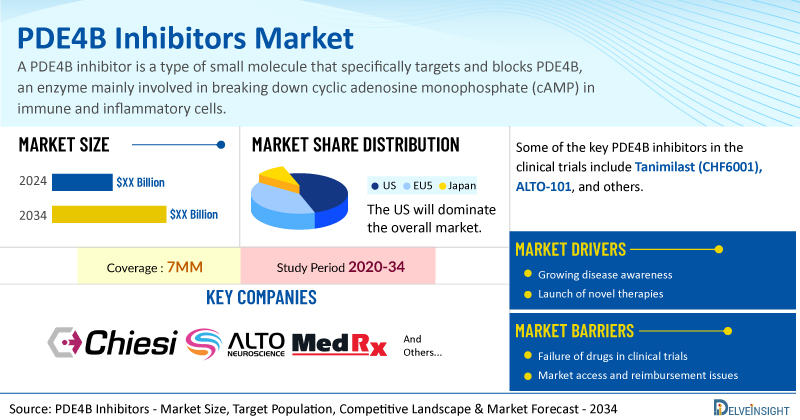PDE4B Inhibitor Market Poised for Strong Growth by 2034 | DelveInsight

New York, USA, Sept. 03, 2025 (GLOBE NEWSWIRE) -- PDE4B Inhibitor Market Poised for Strong Growth by 2034 | DelveInsight The outlook for the PDE4B inhibitors market is changing as this drug class demonstrates significant therapeutic promise in respiratory, dermatologic, and inflammatory diseases. Existing approvals such as OHTUVAYRE, ZORYVE, and EUCRISA have already validated the PDE4 mechanism, while pipeline candidates like tanimilast (CHF6001) and ALTO-101 are paving the way for more specialized and differentiated treatment opportunities.DelveInsight's PDE4B Inhibitors Market Size, Target Population, Competitive Landscape & Market Forecast report includes a comprehensive understanding of current treatment practices, addressable patient population, which includes top target indications such as Chronic Obstructive Pulmonary Disease (COPD), Non-Cystic Fibrosis Bronchiectasis (NCFB), Cystic Fibrosis, Asthma, Plaque Psoriasis, Atopic Dermatitis, Seborrheic Dermatitis, Cognitive Impairment Associated with Schizophrenia (CIAS), and others. The selected indications are based on approved therapies and ongoing pipeline activity. The report also provides insights into the emerging PDE4B inhibitors, market share of individual therapies, and current and forecasted market size from 2020 to 2034, segmented into leading markets (the US, EU4, UK, and Japan).PDE4B Inhibitors Market SummaryAs per DelveInsight's analysis, the total market size of PDE4B inhibitors in the leading markets (the US, EU4, UK, and Japan) is expected to surge significantly by 2034.The report provides the total potential number of patients in the indications, such as Chronic Obstructive Pulmonary Disease (COPD), Non-Cystic Fibrosis Bronchiectasis (NCFB), Cystic fibrosis, Asthma, Plaque Psoriasis, Atopic Dermatitis, Seborrheic Dermatitis, Cognitive Impairment Associated with Schizophrenia (CIAS), and others.Key PDE4B inhibitor companies, such as Chiesi Farmaceutici, Alto Neuroscience, MEDRx, and others, are developing novel PDE4B inhibitors that can be available in the PDE4B inhibitors market in the coming years. Some of the key PDE4B inhibitors in the clinical trials include Tanimilast (CHF6001), ALTO-101, and others.Discover which indication is expected to grab the major PDE4B inhibitors market share @ PDE4B Inhibitors Market ReportKey Factors Driving the Growth of PDE4B Inhibitors Market Broad, growing set of target indications for PDE4B Inhibitors fueling marketPDE4B inhibition is relevant across a wide set of inflammatory and neuroinflammatory diseases, atopic dermatitis, psoriasis, COPD/asthma, and CNS disorders (mood/neurodegenerative), which multiplies addressable market size and creates multiple commercialization pathways.Increasing R&D and pipeline activity in PDE4B Inhibitors going to change market dynamicsEmerging PDE4B inhibitors in clinical trials include tanimilast (CHF6001), ALTO-101, and other pipeline candidates, reflecting growing interest in targeting this pathway for inflammatory respiratory and immune-mediated diseases.Unmet need for steroid-sparing, non-systemic options in dermatology and pulmonary disease opens potential avenues for PDE4B InhibitorsPhysicians and patients increasingly prefer non-steroidal, targeted anti-inflammatory options for long-term disease control (topical creams/ointments, inhaled/nebulized formulations). PDE4B inhibitors are well-suited as steroid-sparing agents, supporting their uptake in chronic care pathways. Market commentary and disease-area reports emphasize this demand.Improved delivery technologies Advances in topical vehicles, inhaled/nebulized delivery, and formulations that lower systemic exposure reduce adverse events and broaden use (e.g., for milder disease or local therapy), enabling larger patient populations to be treated.PDE4B Inhibitors Market AnalysisPDE4B inhibitors present significant multi-indication potential in respiratory, dermatologic, and neuropsychiatric disorders, offering both clinical relevance and commercial opportunity. This positions them as a distinct therapeutic class capable of driving sustained market growth.The success of currently approved PDE4-targeting therapies, including OHTUVAYRE (ensifentrine), ZORYVE (roflumilast), and EUCRISA (crisaborole), underscores the therapeutic importance of PDE4 modulation, validating its commercial value while demonstrating its expanding role across diverse clinical settings.OHTUVAYRE (ensifentrine) is an inhaled small-molecule dual inhibitor of PDE3 and PDE4, enzymes that degrade cAMP and, in the case of PDE3, cGMP. By blocking these pathways, ensifentrine increases intracellular cAMP and cGMP, resulting in bronchodilatory and anti-inflammatory effects. Approved as an inhalation suspension for maintenance treatment of COPD in adults, it introduces a differentiated dual-mechanism approach within a single therapy.Verona Pharma is actively expanding the clinical utility of ensifentrine beyond COPD. Phase II trials are underway for non-cystic fibrosis bronchiectasis (NCFB), cystic fibrosis, and asthma using the nebulized form. At the same time, Metered Dose Inhaler (MDI) and Dry Powder Inhaler (DPI) versions are being evaluated in patients with COPD, cystic fibrosis, and asthma. Furthermore, a nebulized combination with LAMA is being evaluated for the treatment of COPD, reinforcing the company's strategy to establish ensifentrine as a versatile treatment across multiple respiratory diseases and delivery platforms.ZORYVE (roflumilast), another PDE4 inhibitor, works by raising intracellular cAMP through enzymatic blockade, thereby influencing key inflammatory pathways in dermatologic diseases. Although its precise mechanism is not fully understood, its efficacy has been proven across several skin conditions. ZORYVE cream 0.3% is approved for the treatment of plaque psoriasis, including intertriginous areas, in patients aged 6 years and above. In comparison, the 0.15% cream is indicated for mild to moderate atopic dermatitis in the same age group. Additionally, ZORYVE topical foam 0.3% is approved for the treatment of seborrheic dermatitis in patients aged 9 years and older, and for scalp and body plaque psoriasis in patients aged 12 years and older. Development is ongoing for a 0.05% formulation targeting atopic dermatitis in younger pediatric populations, including children aged 2–5 years and infants as young as 3 months.EUCRISA (crisaborole) is a topical PDE4 inhibitor that increases intracellular cAMP to regulate inflammatory pathways involved in atopic dermatitis, though its exact mechanism remains incompletely understood. It is approved for mild to moderate atopic dermatitis in both adults and children from 3 months of age, positioning it as one of the earliest available treatment options across a broad age range.Learn more about the PDE4B inhibitors @ PDE4B Inhibitors AnalysisPDE4B Inhibitors Competitive LandscapeSome of the PDE4B inhibitors in clinical trials include Chiesi Farmaceutici's Tanimilast and Alto Neuroscience/MEDRx's ALTO-101, among others. Chiesi Farmaceutici's Tanimilast is an inhaled anti-inflammatory therapy under development for the treatment of COPD and asthma. As a PDE4 inhibitor, it prevents the breakdown of intracellular cAMP in inflammatory cells, thereby dampening inflammation and regulating immune responses. This mechanism is designed to reduce airway inflammation, alleviate symptoms, and improve lung function in patients with chronic respiratory conditions. The therapy is currently being evaluated in Phase III trials for COPD (NCT04636814) and Phase II trials for asthma.Alto Neuroscience/MEDRx's ALTO-101 is a novel small molecule developed for the treatment of CIAS. It is a brain-penetrant PDE4 inhibitor that blocks the enzyme responsible for degrading cAMP, a key signaling molecule involved in cognition and neuroplasticity. Given the established link between PDE4 inhibition, pro-cognitive effects, and antidepressant activity, ALTO-101 is a strong candidate for CIAS therapy. The drug is delivered via a Transdermal Delivery System (TDS), which minimizes side effects typically associated with PDE4 inhibitors and enables higher dosing, guided by EEG and behavioral biomarkers. The drug is currently in Phase II (NCT06502964) for schizophrenia. In April 2024, Alto Neuroscience announced positive Phase I results for ALTO-101, showing improved pharmacokinetics and tolerability with the transdermal formulation compared to oral dosing. By June 2024, the company had launched a Phase II clinical trial to further evaluate the transdermal version of ALTO-101 for the treatment of CIAS. Earlier studies with the oral formulation demonstrated improvements in cognition and cognition-related EEG markers in humans. The ongoing trial is designed to leverage the advantages of transdermal delivery to optimize treatment outcomes, with top-line results expected in the second half of 2025.The anticipated launch of these emerging therapies are poised to transform the PDE4B inhibitors market landscape in the coming years. As these cutting-edge therapies continue to mature and gain regulatory approval, they are expected to reshape the PDE4B inhibitors market landscape, offering new standards of care and unlocking opportunities for medical innovation and economic growth.To know more about PDE4B inhibitors clinical trials, visit @ PDE4B Inhibitors Treatment PDE4B Inhibitors OverviewA PDE4B inhibitor (a subtype of PDE4 inhibitor) is a type of small molecule that specifically targets and blocks PDE4B, an enzyme mainly involved in breaking down cyclic adenosine monophosphate (cAMP) in immune and inflammatory cells. Inhibition of PDE4B raises intracellular cAMP levels, which in turn produces anti-inflammatory and antifibrotic effects. These inhibitors are currently being explored in preclinical and clinical settings for potential use in conditions such as pulmonary fibrosis, chronic inflammatory disorders, schizophrenia, and related diseases.The selective action on PDE4B, rather than other isoforms like PDE4D, is designed to maintain therapeutic benefits while reducing side effects, such as nausea, that are frequently associated with non-selective PDE4 inhibition. Ongoing research has yielded several chemically diverse and biologically potent PDE4B inhibitors, with some advancing into clinical trials or gaining approval for specific medical applications. As a result of this, the PDE4 inhibitors market is also gaining traction in the coming years.PDE4B Inhibitors Epidemiology SegmentationThe PDE4B inhibitor report provides the total potential number of patients in the indications, such as Chronic Obstructive Pulmonary Disease (COPD), Non-Cystic Fibrosis Bronchiectasis (NCFB), Cystic Fibrosis, Asthma, Plaque Psoriasis, Atopic Dermatitis, Seborrheic Dermatitis, Cognitive Impairment Associated with Schizophrenia (CIAS), and others. According to DelveInsight's estimates, in 2024, there were ~30 million diagnosed ...Full story available on Benzinga.com













